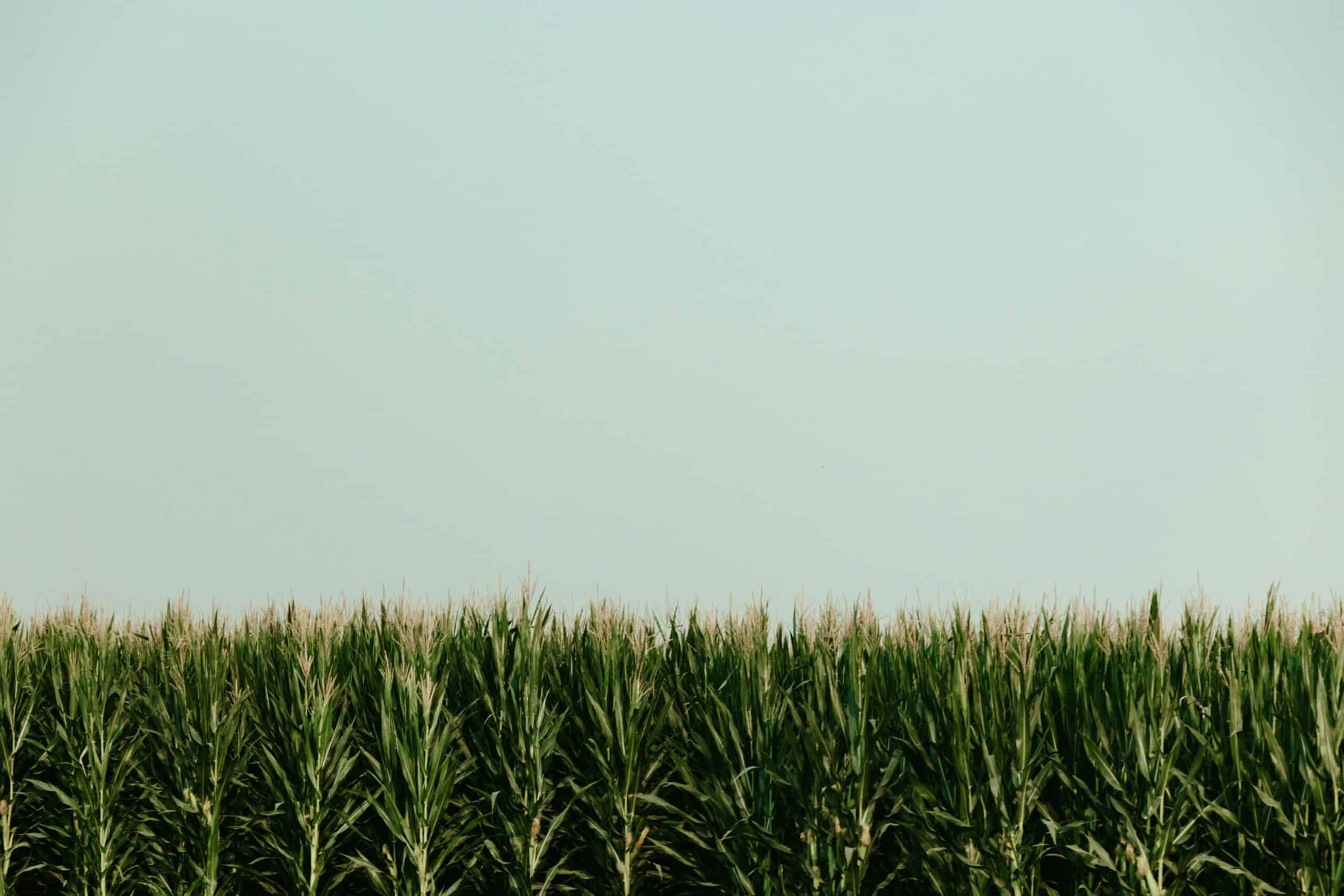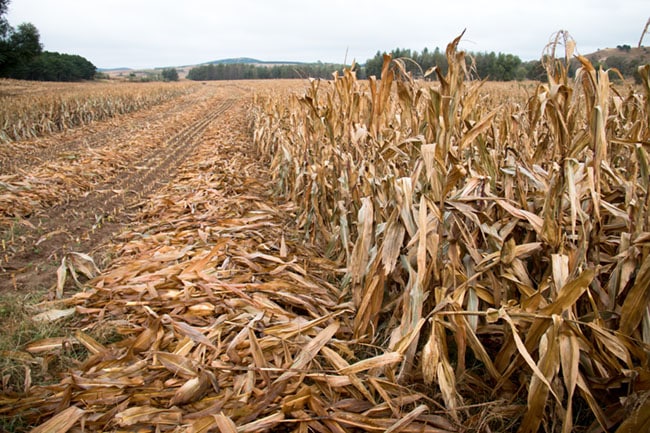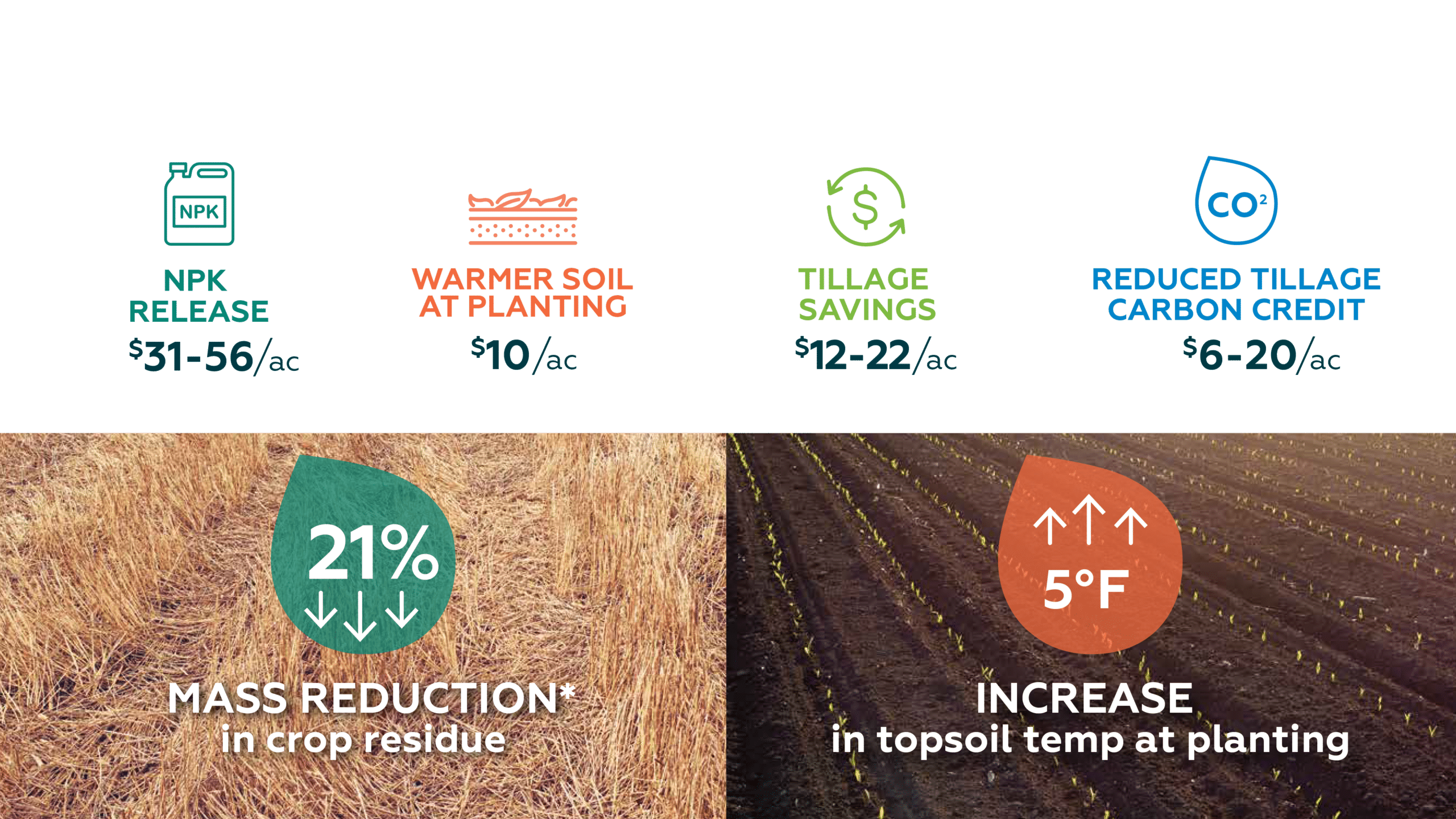Apr 11, 2025

Corn is a lucrative crop. Yet aspects of the return-on-investment leaves growers scratching their heads. The sprawling acres of corn stalks are a reminder of a productive season – that will soon become a money pit as you remove the stalks. Any grower knows that once you collect all the kernels, the work (and investment) continues. It’s common to wonder, “What should I do with my corn stalks after harvest?”
How growers handle post-harvest stalks can significantly impact soil health, your future crop yield potential, and your return on investment. The good news for corn growers is there is now a better way to manage your remaining corn stalks after harvest. It’s easier than baling and using stalks for animal bedding. It’s healthier for your soil than tilling. Plus, it produces impressive return on investments in next year’s harvest.
You can now manage your dead corn stalks by feeding your soil microbes a carbon rich food, like PhycoTerra. Once fed, the microbes wake up and begin to break down your leftover stalks, and cycle the nutrients back into your soil for your future crops.
Let’s get rid of the post-harvest money pit, and turn each piece of your entire plant into a return on investment.
A corn stalk’s hardiness, while a trait most growers are grateful for in spring and summer, becomes a nuisance when planting fall crops and during next spring’s planting. Their tough, fibrous structure is the result of specific genetic traits like stay-green genes. We’ve engineered the entire plant not to break down easily. Growers have also included foliar fungicides and nutrient applications. These protect and enhance your crops, but inadvertently contribute to the overall resilience – even after corn is harvested.
Though these genes provide a sturdy frame throughout the growing season, it does make post-harvest decomposition slow. For corn stalks to even begin to break down, five things must be present:
Decomposition rate slows dramatically in colder climates compared to warmer ones, like in the northern Corn Belt. In climates that regularly drop below 50 degrees Fahrenheit, stalks defy decomposition and remain intact until spring.
Soil health and the microbiology in your soil is an essential part of the decomposition process. 75% of soil microbes in farm soils are either dormant or asleep due to starvation. When your microbes aren’t awake, they won’t be able to help break down stalks.
Depending on the variables mentioned above, corn stalks can break down in as little as two to three months (if added to a composter), or as long as three years.
Corn residue does have many important agricultural uses. It is a good idea to leave some, if not most of your corn stalks in the ground. By this we mean cutting up stalks and dispersing them throughout your field, and not necessarily leaving the entire stalk intact for the winter. Most growers will chop corn stalks down to 12 to 18 inches. This is widely used practice because cutting corn stalks can help with decomposition in two ways.
First, cutting stalks increases airflow movement down the rows, which increases the rate of stalk decomposition.
Second, cutting down stalks and dispersing them throughout your field also allows soil microbes to access them, which can increase the rate of decomposition and cycle nutrients back into your soil.
Corn stalk provides the soil with phosphate, potash, nitrogen, calcium, magnesium, sulfur and micronutrients. Some of these nutrients release after interacting with precipitation. Others like nitrogen and phosphorus are tied up in organic matter and released during mineralization in the following spring or summer.
When the stalk residue breaks down in your fields, it improves the organic matter in the soil. When you remove the stalks (via baling, or grazing, for example), your soil will include less organic matter. Less organic matter can lead to reduced soil health, and reduced yields over time if amendments aren’t made to the soil.

Despite the numerous benefits, leaving corn stalks in the ground does have some drawbacks. For example, it can increase your chances of sap beetle outbreaks. Additionally, not cutting down stalks can create issues when it’s time to plant, especially if none of them have decomposed, like in colder regions.
If you’re left with the hardy, fibrous crop residue come planting time, keep an eye on your equipment. Some corn stalks can puncture and deflate tires!
While the sturdy structure of the corn stalk might present a decomposition challenge, there are various ways farmers can utilize this resource effectively for any kind of corn.
Composting: Green corn stalks, which are richer in nutrients than their dried counterparts, can be turned into compost. Note, while using a composter is a faster way to break down corn residue, this often is not an option for corn farmers with larger operations.
Baling for Animal Bedding: If you have livestock on your farm, or know farmers who have livestock, corn stalks can be a comfortable substitute bedding for straw. This yields a small return on investment. That said, you may not break even given labor and fuel are expensive.
Grazing: If you, or neighboring farms have livestock, post-harvest stalks can be a good option for grazing livestock like cattle, chickens, goats, horses and rabbits. It’s cost effective, as the animals will be eating food already paid for via crop production. Make sure to only use the stalks as an additive and not the full meal replacement. The corn stalks are high in fiber, so don’t feed livestock large amounts of it.
Also, be sure to rotate cows off the field before they consume the last 18 to 24 inches of stalks, as this can lead to nitrate poisoning.
Decoration Use: If your farm already hosts pumpkin patches, or fall festivities, you could consider selling dried corn stalks. These are often used for decoration in the fall, and could provide some return on investment. This is not an ideal use if you have a larger field spanning multiple acres.
The main drawback of these options is the reduction in organic matter in your field, meaning less nutrients to support future corn plants. Additionally, it should be noted that it is not recommended to implement these practices every year and when implemented, it is further recommended that not every row of stalks be cut down to help avoid soil erosion.
Ground Cover: Like mulch, corn stalks can provide insulation for your farm fields and smother early spring weeds.
Utilizing Cover Crops: Planting cover crops in a cornfield full of stalks can help break down residue, cycle nutrients, reduce runoff and erosion, increase infiltration, and warm soils in the spring. This method requires careful timing, as some cover crops can dry out your field or create more residue if not accounted for, making planting season even more complicated. Be sure to consider how easy it will be to break up in the spring!
Tillage: The main advantage of tillage is incorporation of stalk residue into the soil where microbes will decompose the material. With less residue on the surface, there will be an increased chance of higher soil temperatures and early planting. Yet, this leaves your fields susceptible to wind and water erosion. It also has a higher production cost between labor and diesel compared to no-till or low-till methods. Continuous tilling can also increase soil compaction, which damages your soil microbiome and soil health.
Recent studies also suggest tillage doesn’t always increase decay rates, rather it’s a biological process influenced by the environment, like temperature and moisture, and soil conditions, like pH and nutrient supply. Exclusively mixing corn stalks into your soil won’t solve your decomposition problem, a healthy and active microbiome is also essential.
Feed them to your Soil Microbes: While it may sound counter-intuitive, you can just leave the corn residue in your field. Pairing a carbon product like PhycoTerra with your burn-down application will activate soil microbes to speed up decomposition by using leftover stalks as food, and cycle nutrients back into your soil for next year’s crops. Your leftover corn can provide essential nutrients to the soil, promoting a healthy ecosystem.
The biggest benefit of leaving cut up stalks in your field is the entire plant will recirculate nutrients back into the soil for your future crops.
Until recently, all techniques for managing corn stalks had pros and cons. Tilling helped protect machinery tires, but also caused soil compaction. Baling stalks for bedding produced a small return-on-investment, but only when the cost of labor and diesel was low. Grazing is one of the more profitable options, yet, livestock can’t eat the entire corn stalk – so, you’ll still have 18 inches of stalk to decompose.
Growers needed a cost effective way to reduce the amount of post-harvest residue in their fields after planting corn that contributed to the organic matter in the soil and produced a healthy return on investment.
Our solution is an award-winning carbon product to wake up soil microbes and put them to work decomposing leftover corn stalks. These stalks then improve the overall soil health and act as a slow-release nutrient supply for next year’s crops.
It also provides growers with an impressive return on investment, which includes:

Yes, consider planting early maturing hybrids of corn that can be harvested and cut in mid-September. This will give you a longer window in the warmer weather for stalks to naturally break down.
You can also use a chopping corn head or vertical tillage to break up stalks and leave them on your soil surface. Make sure to conduct a soil test before chopping or vertical tilling to check if you have a diverse and active microbiome. Once you know more about the beneficial microbes in your soil, you can feed them a carbon-rich product like PhycoTerra which breaks down the remaining stalks faster. If you don’t have a healthy and active microbiome, it can take a very long time for the corn stalks to eventually break down.
Growers who used PhycoTerra found an average of 21% greater mass reduction of crop residue compared to the non-treated control.
It’s safe to say Robert Frost wasn’t a corn farmer when he famously wrote “Nothing gold can stay”. Yet, with the right practices, there is a chance corn farmers won’t be cursing last year’s stalks when it’s time to plant again. Even when there’s been an especially healthy corn year.
While weather, soil type, farm size, fertilization practices, and crop production scale can all play a role in determining what method of residue reduction you use, all growers benefit from applying PhycoTerra. It’s the best option, financially and in practice to deal with leftover stalks, even for corn-on-corn growers in colder regions.
Want to find out how PhycoTerra could increase your yields, and reduce your post-harvest stalks? Fill out a contact form to get started.
Or, learn more about our innovative way of breaking down post-harvest residue.
Note: All trial data is current as of blog posting. For the most up to date trail data, please visit our trials page.